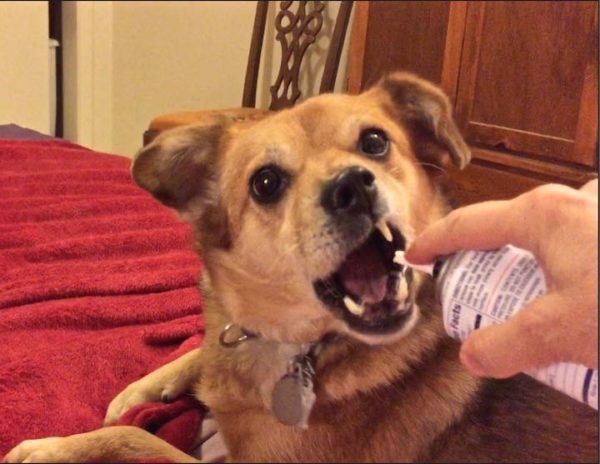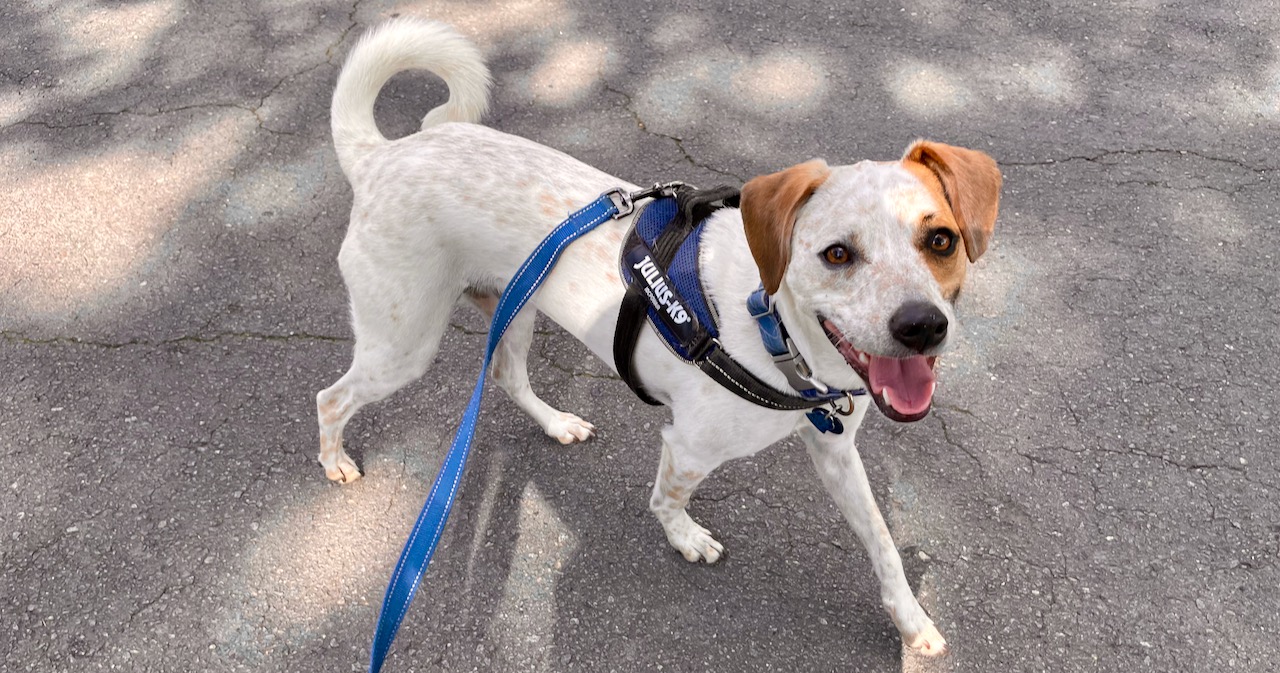Is your dog scared of fireworks? Don’t wait until the holiday hits. Even with just a couple days’ lead time, you can make a plan and take action now to help your dog be less afraid of the unpredictable scary sounds of fireworks, firecrackers, whistles, and even guns.
Get Ready
Here are some things you can do starting today or tomorrow.
- Check into medications. If your dog gets very anxious about noises and you have never talked to your vet about it, do so now. He or she may be able to prescribe something to help. And if you can’t get in before the holiday, do your best with some of the other ideas here to get through it and call your vet as soon as you can. This is a long-term problem. Sound phobias tend to get worse and are not something to be taken lightly.
- Countercondition to noises. Get some great treats and start carrying them around. Whenever there is any kind of sudden or startling noise, including stray bangs and booms as people test their noisemakers, rain treats down on your dog. Use those special treats only for noises; don’t pass them out for nice behavior (use something else for that!), and don’t ask for any particular behavior from your dog when the noise occurs. Just give the special treats.
You may wonder why I am not recommending buying an app, CD, or YouTube video with fireworks sounds to “practice” with. Performing desensitization/counterconditioning with sounds is tricky. People who haven’t done DS/CC before run a real risk of scaring their dogs further instead of helping them. This is why I am suggesting this method, which uses environmental noises that are happening anyway. It’s called ad hoc counterconditioning and there is evidence from studies that it is effective, including this study that is specific to fireworks. Save the formal training for after the holiday, when you can keep your dog safe from accidental exposures to the sound.
- Create a safe place. Make (or adapt) a safe place for your dog. Keep in mind that the flashes of light that come with big fireworks displays can be scary too, so consider a method to temporarily darken any windows nearby. Also, please know that acoustic foam and even sound blankets don’t do a thing for low-frequency booms. The big fireworks sounds can’t be “soundproofed” against except with materials that are much too big and heavy to use inside most houses and are not do-it-yourself friendly. Get the best protection you can in a basement or your most internal room. Despite the marketing claims, dog crates with walls a few inches thick can’t dampen low-frequency sounds to an effective degree, either. The walls of your house are probably five to ten inches thick and include insulation, but you can still hear thunder inside your house, right? But if a crate is your dog’s safe place, that’s great. And a blanket over it can muffle echos and create a cozy feeling for humans and perhaps dogs. Here are some examples of safe places for dogs.
- Play sound or music. Experiment with sound masking to find out what is most helpful for your situation. Try some kind of recorded white or brown noise, natural noise, or music to mask the pops and booms. (Even a noisy food toy can be helpful.) This approach is evidence-based and is called sound masking.
And here’s a tip: the lower the frequencies included in the masking or music, the better it can hide those low-pitched booms (Kinsler et al., 1999, p.318–320; Gelfand, 2017, p. 187). So if your dogs are already habituated to pounding rock music, metal, or some other music with a lot of bass or percussion, play it! And play it on your best sound system to include those low frequencies. It can mask some of the scary noises coming from outside your house more effectively. Taiko drumming is great if your dogs are accustomed to it. You can buy a few songs and loop them or find some on YouTube. But be absolutely certain that the music itself doesn’t scare your dogs first. If they are already sensitive to booms, it probably will.
Household appliances can help. Some floor fans hit fairly low frequencies and can be helpful. You can run the dryer (no heat) with a pair of sports shoes in it for some booms that will probably be familiar and not scary. You’ll need to find the line of best fit for your dogs.
A great resource for some households is the Bang-Dog Playlist from Triplet Noir Studios. These are metal selections (be aware that some of the language is not family-friendly). Before anyone mentions it: that’s right, heavy metal has not ranked well in the dogs and music studies, tending to make shelter dogs more agitated (Kogan et al., 2012). That’s not surprising. But if you play it already and your dogs are fine with it, they are habituated. In that case, this music could be the very thing for you and your dog.
- Practice going out. Make a plan for taking your dog out to potty. Do you know when the noise is usually at its worst and can you work around that? Are your fences and/or leash and harness secure? If your dog is not used to being on-leash for potty time, start practicing now, including getting the harness on. Dogs who are usually sedate may panic and run off on noisy holidays. Don’t let that happen. Keep your gates locked, your dogs’ ID tags on, and put some redundancy into your safety system.
- Comfort your dog if that helps. LOSE that idea that there’s something wrong with comforting your dog, if that’s what your dog wants. Helping a dog through a tough time is not “coddling.” Assess what is most helpful to your dog: a cuddle, food or a fun game after every scary noise, some lap time, sweet talk, being in their crate with a food toy, or hiding by themselves in a secluded place. Then help them do it. If they want to hide, let them.
Check out more resources and tips on my page “You Can’t Reinforce Fear.“
Another good resource is this article by Val Hughes: My Dog Fears Fireworks and Thunderstorms—What Should I Do To Help? Her article has suggestions for both long- and short-term solutions.
References
Gelfand, S. A. (2017). Hearing: An introduction to psychological and physiological acoustics. CRC Press.
Kinsler, L. E., Frey, A. R., Coppens, A. B., & Sanders, J. V. (2000). Fundamentals of acoustics. John Wiley & Sons.
Kogan, L. R., Schoenfeld-Tacher, R., & Simon, A. A. (2012). Behavioral effects of auditory stimulation on kenneled dogs. Journal of Veterinary Behavior, 7(5), 268-275.
Riemer, S. (2020). Effectiveness of treatments for firework fears in dogs. Journal of veterinary behavior, 37, 61-70.
© Eileen Anderson 2015



